
(a)
Interpretation:
The mechanism and product for the given reactions, when they are catalyzed by the base, are to be drawn.
Concept introduction:
The carbonyl carbon is electrophilic in nature due to the electronegativity difference. The nucleophile adds the electrophilic carbon of the carbonyl group. The reaction follows a different mechanism for an acid and a base catalyst. When the reaction is catalyzed by the acid, the first step of the reaction is always protonation of the carbonyl oxygen, which increases the electrophilicity of the carbonyl carbon. For a base-catalyzed reaction, the first step is the deprotonation of the nucleophilic species to form the anion, which helps to enhance the nucleophilic character.
Answer to Problem 18.46P
- The mechanism for the first reaction, when it catalyzed by the base:

- The product for the first reaction, when it catalyzed by the base:
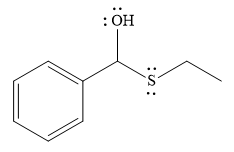
- The mechanism for the second reaction, when it catalyzed by the base:
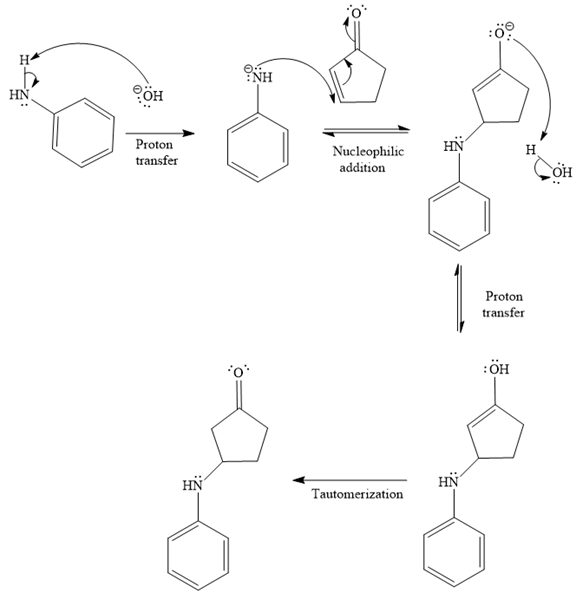
- The product for the second reaction, when it catalyzed by the base:
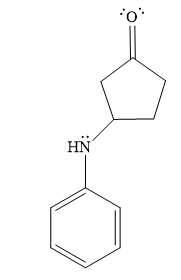
Explanation of Solution
The first given reaction is
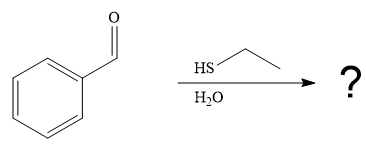
Under the basic condition, the base (

The nucleophile adds the electrophilic carbon of the given substrate, leading to form an alkoxide ion. Alkoxide ion then abstracts proton from the solvent, water, to form the uncharged product.

Thus, the product of the first reaction, when it catalyzed by the base, is

The second given reaction is
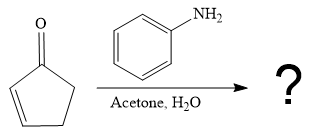
Under the basic condition, the base (
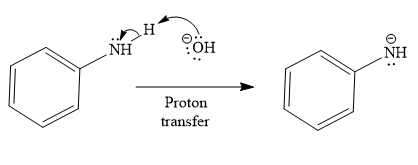
In the second step, the attack of the nucleophile (
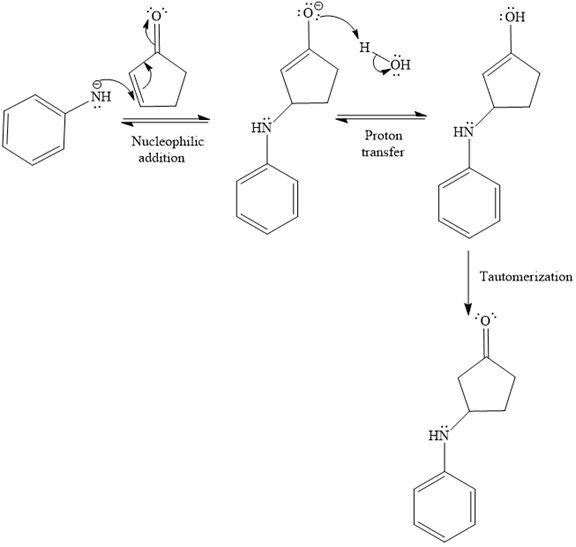
Thus, the product of the given reaction is

The mechanism and product for the given reaction are drawn on the basis of the reaction condition.
(b)
Interpretation:
The mechanism and product for the given reactions, when they are catalyzed by the acid, are to be drawn.
Concept introduction:
The carbonyl carbon is electrophilic in nature due to the electronegativity difference. The nucleophile adds the electrophilic carbon of the carbonyl group. The reaction follows a different mechanism for an acid and a base catalyst. When the reaction is catalyzed by the acid, the first step of the reaction is always protonation of the carbonyl carbon, which increases the electrophilicity of the carbonyl oxygen. For a base-catalyzed reaction, the first step is the deprotonation of the nucleophilic species to enhance the nucleophilic character.
Answer to Problem 18.46P
- The mechanism for the first given reaction, when it catalyzed by the acid:
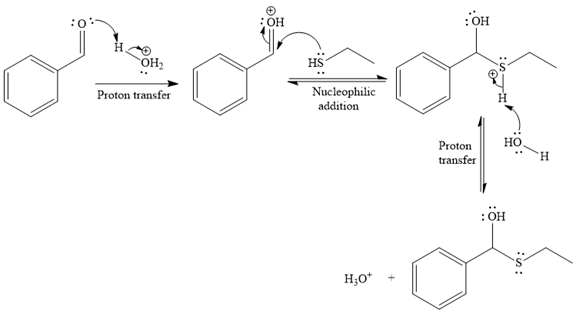
- The product for the first reaction, when it catalyzed by the acid:

- The mechanism for the second reaction, when it catalyzed by the acid:
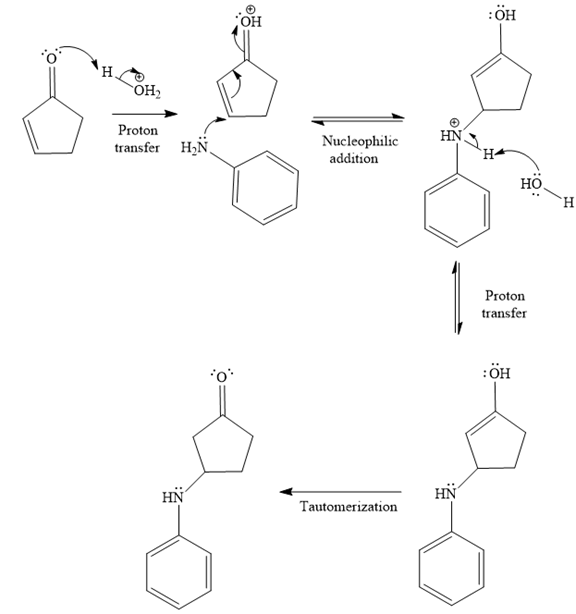
- The product for the second reaction, when it catalyzed by the acid:

Explanation of Solution
The first given reaction is

Under the acidic condition, the carbonyl oxygen of the given reactant (an
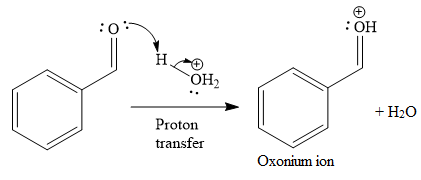
Then the nucleophile attack of (

Thus, the product of the given reaction is

The second given reaction is

Under the acidic condition, the carbonyl oxygen of the given reactant (

In the second step, the attack of the nucleophile (
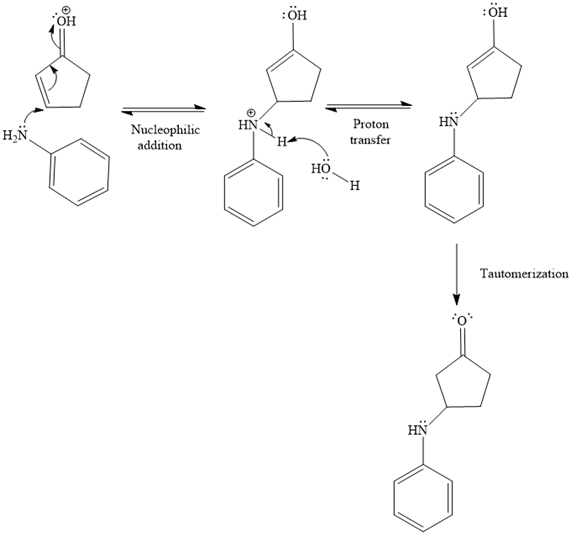
Thus, the product of the given reaction is

The mechanism and product for the given reaction are drawn on the basis of the reaction condition.
Want to see more full solutions like this?
Chapter 18 Solutions
Get Ready for Organic Chemistry
- Q1: Answer the questions for the reaction below: ..!! Br OH a) Predict the product(s) of the reaction. b) Is the substrate optically active? Are the product(s) optically active as a mix? c) Draw the curved arrow mechanism for the reaction. d) What happens to the SN1 reaction rate in each of these instances: 1. Change the substrate to Br "CI 2. Change the substrate to 3. Change the solvent from 100% CH3CH2OH to 10% CH3CH2OH + 90% DMF 4. Increase the substrate concentration by 3-fold.arrow_forwardExperiment 27 hates & Mechanisms of Reations Method I visual Clock Reaction A. Concentration effects on reaction Rates Iodine Run [I] mol/L [S₂082] | Time mo/L (SCC) 0.04 54.7 Log 1/ Time Temp Log [ ] 13,20] (time) / [I] 199 20.06 23.0 30.04 0.04 0.04 80.0 22.8 45 40.02 0.04 79.0 21.6 50.08 0.03 51.0 22.4 60-080-02 95.0 23.4 7 0.08 0-01 1970 23.4 8 0.08 0.04 16.1 22.6arrow_forward(15 pts) Consider the molecule B2H6. Generate a molecular orbital diagram but this time using a different approach that draws on your knowledge and ability to put concepts together. First use VSEPR or some other method to make sure you know the ground state structure of the molecule. Next, generate an MO diagram for BH2. Sketch the highest occupied and lowest unoccupied MOs of the BH2 fragment. These are called frontier orbitals. Now use these frontier orbitals as your basis set for producing LGO's for B2H6. Since the BH2 frontier orbitals become the LGOS, you will have to think about what is in the middle of the molecule and treat its basis as well. Do you arrive at the same qualitative MO diagram as is discussed in the book? Sketch the new highest occupied and lowest unoccupied MOs for the molecule (B2H6).arrow_forward
- Q8: Propose an efficient synthesis of cyclopentene from cyclopentane.arrow_forwardQ7: Use compound A-D, design two different ways to synthesize E. Which way is preferred? Please explain. CH3I ONa NaOCH 3 A B C D E OCH3arrow_forwardPredict major product(s) for the following reactions. Note the mechanism(s) of the reactions (SN1, E1, SN2 or E2).arrow_forward
- (10 pts) The density of metallic copper is 8.92 g cm³. The structure of this metal is cubic close-packed. What is the atomic radius of copper in copper metal?arrow_forwardPredict major product(s) for the following reactions. Note the mechanism(s) of the reactions (SN1, E1, SN2 or E2).arrow_forwardPredict major product(s) for the following reactions. Note the mechanism(s) of the reactions (SN1, E1, SN2 or E2).arrow_forward
- Q3: Rank the following compounds in increasing reactivity of E1 and E2 eliminations, respectively. Br ca. go do A CI CI B C CI Darrow_forwardQ5: Predict major product(s) for the following reactions. Note the mechanism(s) of the reactions (SN1, E1, SN2 or E2). H₂O דיי "Br KN3 CH3CH2OH NaNH2 NH3 Page 3 of 6 Chem 0310 Organic Chemistry 1 HW Problem Sets CI Br excess NaOCH 3 CH3OH Br KOC(CH3)3 DuckDuckGarrow_forwardQ4: Circle the substrate that gives a single alkene product in a E2 elimination. CI CI Br Brarrow_forward
 ChemistryChemistryISBN:9781305957404Author:Steven S. Zumdahl, Susan A. Zumdahl, Donald J. DeCostePublisher:Cengage Learning
ChemistryChemistryISBN:9781305957404Author:Steven S. Zumdahl, Susan A. Zumdahl, Donald J. DeCostePublisher:Cengage Learning ChemistryChemistryISBN:9781259911156Author:Raymond Chang Dr., Jason Overby ProfessorPublisher:McGraw-Hill Education
ChemistryChemistryISBN:9781259911156Author:Raymond Chang Dr., Jason Overby ProfessorPublisher:McGraw-Hill Education Principles of Instrumental AnalysisChemistryISBN:9781305577213Author:Douglas A. Skoog, F. James Holler, Stanley R. CrouchPublisher:Cengage Learning
Principles of Instrumental AnalysisChemistryISBN:9781305577213Author:Douglas A. Skoog, F. James Holler, Stanley R. CrouchPublisher:Cengage Learning Organic ChemistryChemistryISBN:9780078021558Author:Janice Gorzynski Smith Dr.Publisher:McGraw-Hill Education
Organic ChemistryChemistryISBN:9780078021558Author:Janice Gorzynski Smith Dr.Publisher:McGraw-Hill Education Chemistry: Principles and ReactionsChemistryISBN:9781305079373Author:William L. Masterton, Cecile N. HurleyPublisher:Cengage Learning
Chemistry: Principles and ReactionsChemistryISBN:9781305079373Author:William L. Masterton, Cecile N. HurleyPublisher:Cengage Learning Elementary Principles of Chemical Processes, Bind...ChemistryISBN:9781118431221Author:Richard M. Felder, Ronald W. Rousseau, Lisa G. BullardPublisher:WILEY
Elementary Principles of Chemical Processes, Bind...ChemistryISBN:9781118431221Author:Richard M. Felder, Ronald W. Rousseau, Lisa G. BullardPublisher:WILEY





